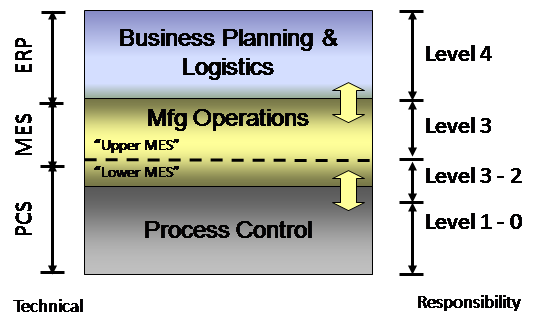

Since its initial definition in the 1990s, the ANSI/ISA-95 standards on Enterprise-Control System Integration have been widely referenced and applied as the basis for integrating enterprise and control systems. They have also been adopted internationally as IEC 62264. With more recent developments and trends such as the Industrial Internet of Things (IIoT), Edge Computing, and Big Data, various pundits and commentators have questioned the continued relevance of these standards in the face of new and emerging architectures. Others have suggested various modifications or improvements to the models that form the basis of these standards.
Perhaps the most familiar of these models is the general reference model, which describes a logical hierarchy of systems used in manufacturing operations and control. Unfortunately, this model has become so well known that it is common for people to disregard the other aspects of the ANSI/ISA-95 standards. There are actually several standards in the ISA-95 series, each dealing with a specific aspect of the integration of enterprise and manufacturing systems. The committee developed these standards – as well as several associated technical reports – over a period of several years, as views and practices evolved.
And yet, when asked about their knowledge of the standards, most people will immediately cite the general reference model. There is a general tendency to interpret it too literally, equating the logical levels as physical domains for implementation. This confusion of system with function in turn leads to concerns such as those stated above. The ISA-95 standards can certainly be applied to a variety of implementations across several industries and infrastructure configurations.
Some have suggested that the reference model will “flatten” as the lines blur between functions in the various levels. Some predict that the operations and control levels will merge as industrial control systems become more sophisticated and capable. Others have suggested a similar convergence of the enterprise and operations levels. Will such a convergence occur, leading to an effective “pancaking” of the model? The short answer is “no.” Analysts have been predicting such a shift for decades, and while some functions may have moved slightly between levels, the basic structure has survived.
Rather than focusing on the characteristics of each level, it is more effective to consider the various activities they contain. This is the purpose of the ANSI/ISA-95.00.03 standard. It is possible to interpret the activity models in this standard in several ways, positioning the activities according to the needs of the business models. One such approach is to consider how the business in question considers each of the ISA-95 functional levels in terms of relative “thickness” or importance to their operation.

This is just one example of how broadly applicable standards such as those in the ISA-95 series can be adapted for various circumstances, without compromising the fundamental concepts. The ISA-95 committee members understand this, and have demonstrated a willingness to evolve and update the standards as circumstances require.
This committee has taken a similar approach in response to recent developments and changing requirements. They are working on specific additions and improvements to the standards to satisfy the latest requirements of industry, including but not limited to Industrie 4.0 and IIoT. Planned changes include updates to the existing part 2, 4 and 5 standards, as well as development of two new standards. ISA-95 part 8 will address Management Information Exchange Profiles, and part 9 will address Common Operations Management Events. Committee leaders are offering a series of webcasts to familiarize stakeholders on these and related changes.
The standards continue to evolve, as they must. The result of this evolution can be described in terms of several possible outcomes:
Ultimately, which of these scenarios will prevail will depend on understanding and acceptance by stakeholders ranging from suppliers and integrators to asset owners. Time will tell.

